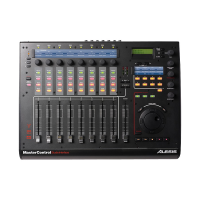Chapter 3: Basics of Analog Synthesis
ANDROMEDA A6 REFERENCE MANUAL 87
LFOs
In addition to loudness and brightness dynamics, everyday sounds are often
enhanced with repeating, patterned fluctuations we recognize as vibrato. In one of its
more expressive applications, a singer often adds vibrato at the end of a sustained
note. As an extreme example, you can think of the high rise and fall of a police siren
as vibrato on steroids.
A synthesizer uses Low Frequency Oscillators (LFOs) to introduce vibrato to the
sound. Designed much like the oscillators that produce raw waveforms as the synth’s
primary sound source, LFOs are not heard but are used to modulate, or change, many
components of the sound that you can hear: the oscillators, filters, overall loudness
and many others.
LFOs use the same waveform types as the oscillators, but their frequency range is
much lower (hence the term “low frequency”) because the typical speed of LFO
modulation is below the range of an audio oscillator. Using our original graph of a
sine wave on page 82, the following illustration shows how this wave affects a
sustained note.
Middle C

